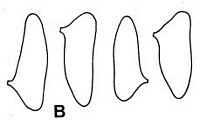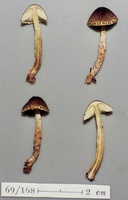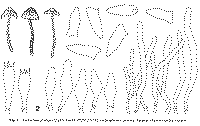|
 Lepiota grangei Lepiota grangei
SynonymsLepiotula grangei
Schulzeria grangei
BiostatusPresent in region - Exotic
Images (click to enlarge)
Caption: Fig. 15. B. Lepiota grangei (EYRE) LANGE (ZT 69/168): spores. | 
Caption: ZT69-168
Owner: E. Horak: © Creative Commons Attribution-Noncommercial 3.0 New Zealand |  |
Article: Horak, E. (1980). On Australasian species of Lepiota S.F. Gray (Agaricales) with spurred spores. Sydowia 33: 111-144.
Habitat: Habitat. - On soil in forests. - Eurasia, Argentina, New Zealand.
Notes: Remarks. - The peculiar green-black colour on pileus and stipe and the rather large, spurred spores
are distinctive characters of L. grangei (EYRE). The material gathered in the two New Zealand
localities agrees in all details with topotypic specimens from England. Lepiota griseovirens
MAIRE (1928), another species with green-olive colours, is separated from L. grangei by its
distinctly smaller spores.
According to HONGO (1959: 76) L. ossaeiformispora IMAI (1933: 43) is probably conspecific to
L. grangei which means its area of distribution probably covers the whole Eurasian region
(VASSILIEVA, 1973: 180).
The above mentioned records from New Zealand and Argentina indicate that L. grangei also
occurs in the more temperate zones of the southern hemisphere.
Article: Horak, E. (1980). Fungi Agaricini Novazelandiae. IX. Lepiotula (Maire) Locquin ex Horak. New Zealand Journal of Botany 18(2): 183-188 (http://www.rsnz.org/publish/abstracts.php).
Description: Pileus -15 mm, hemispheric, convex or campanulate; dark brown to black with distinct green or olive tint; velutinous to tomenlose, continuous over disc, disrupted into ± concentrically arranged coarse squamules towards the non-striate margin; dry, not hygrophanous, margin often dentate from veil remnants. Lamellae (L 14-18, -3), crowded, free, ventricose; white to cream, often with greenish tinge when young, edge entire, concolorous. Stipe -40 x -2.5 mm, cylindric, central, equal or subclavate at base; concolorous with lamellae, becoming pale orange towards base (in aged specimens); covered with green-black veil remnants forming appressed incomplete belts or coarse squamules, fibrillose cortina not observed; dry, longitudinally fibrillose, fistulose, single and in groups. Context white' (occasionally with greenish tinge) in pileus, brown to orange-brown in cortex of stipe, especially near base. Odour and taste strongly acidulous. Chemical reactions on pileus:KOH - negative. Spore print white. Spores 10-14 x 3-4.5 µm, spurred, hyaline, dextrinoid, smooth. Basidia 20-30 x 7-10 µm,'' 4-spored. Cheilocystidia 20-40 x 7-11 µm, fusoid, membrane thin-walled, hyaline, forming sterile seam' on lamellar edge. Pleuro- and caulocystidia none. Cuticle a palisade of erect, cylindric or subclavate; cells (50-180 x 6-12 µm), membrane thin-walled pigment of membrane green (brown). Clamp connections present, sometimes scattered on septa.
Habitat: among litter and debris in forests. New Zealand, Europe, Argentina (Tierra del Fuego).
Notes: Lepiotula grangei is readily recognised by the olive-green tints on pileus and stipe. It is a widespread species which occurs both in the Southern and Northern, Hemispheres. The New Zealand specimen has been compared with topotypic material from Europe and there are no noticeable differences regarding the macroscopic and microscopic characters.
|